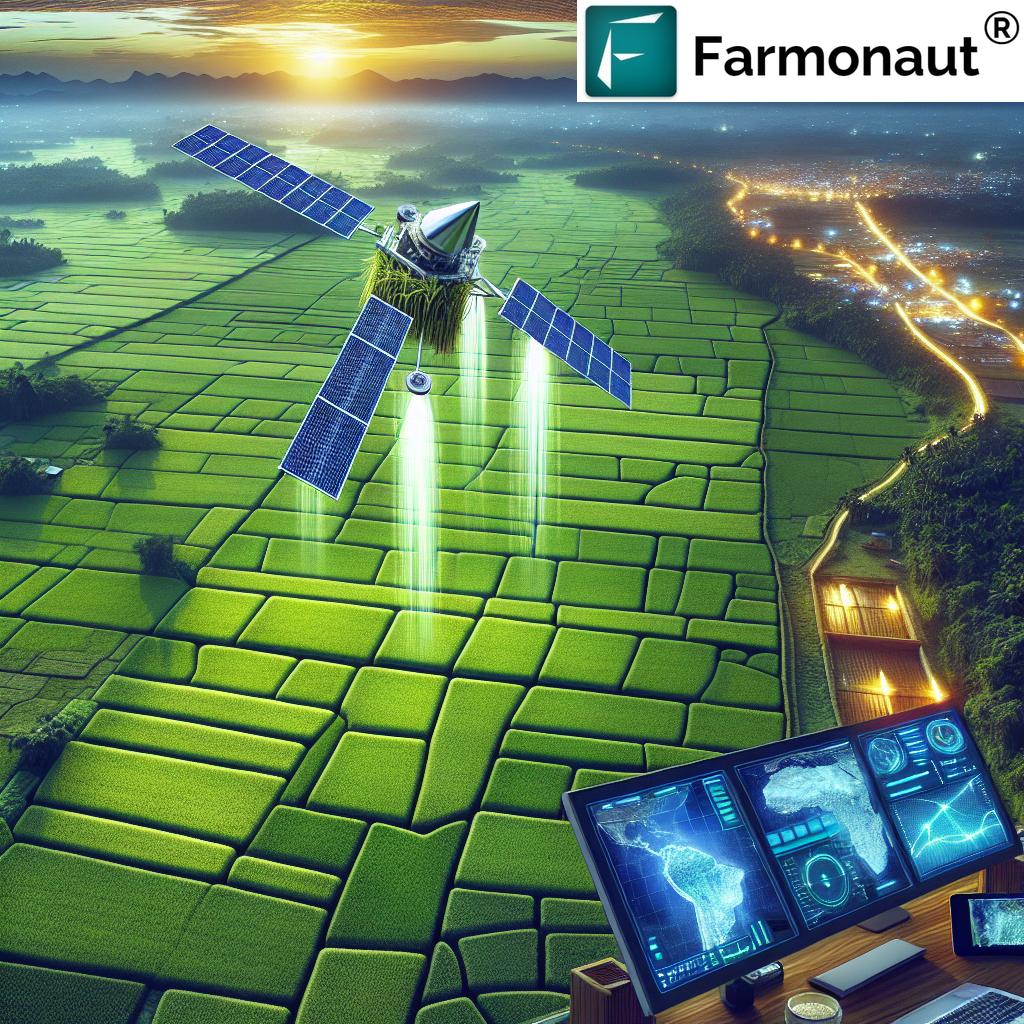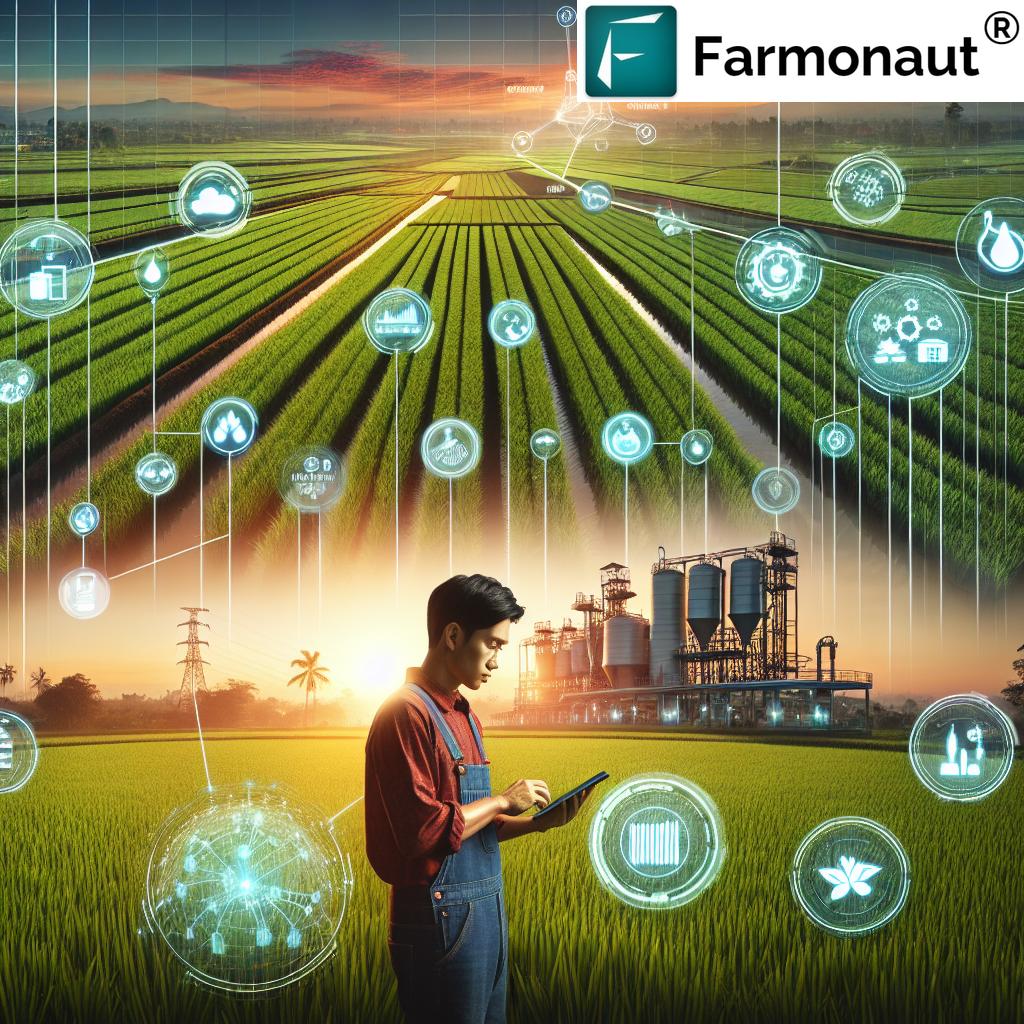Revolutionizing Rice Farming in Andhra Pradesh: AI-Powered Early Pest Detection for Sustainable Agriculture
“AI-powered pest detection in Andhra Pradesh rice farms can identify threats up to 10 days earlier than traditional methods.”
In the lush paddy fields of Andhra Pradesh, a quiet revolution is taking place. We are witnessing the dawn of a new era in rice cultivation, where artificial intelligence (AI) and remote sensing technologies are transforming the way farmers manage pests and diseases. This groundbreaking approach to early pest detection in rice farming is not just enhancing crop health; it’s paving the way for more sustainable and productive agricultural practices.
As we delve into this exciting frontier of agri-tech, we’ll explore how innovative smart farming technologies are addressing the age-old challenges faced by paddy farmers. From the integration of Geographic Information Systems (GIS) to the application of Earth observation techniques, we’re uncovering a world where data-driven farming practices are becoming the norm, not the exception.
The Rice Cultivation Landscape in Andhra Pradesh
Andhra Pradesh, often referred to as the ‘Rice Bowl of India’, has long been at the forefront of rice production in the country. However, the state’s farmers have consistently grappled with the perennial issues of pest infestations and crop diseases. These challenges not only threaten food security but also impact the livelihoods of millions of farmers who depend on successful harvests.
- Traditional pest management relies heavily on manual field scouting
- Farmers often resort to excessive pesticide use, leading to environmental concerns
- Delayed detection of pests and diseases results in significant crop losses
Enter the era of AI-powered early pest detection. This revolutionary approach is changing the game for rice farmers across the state, offering a proactive solution to age-old problems.
The Promise of AI in Agriculture
Artificial intelligence in agriculture is not just a buzzword; it’s a transformative force that’s reshaping farming practices worldwide. In the context of rice cultivation in Andhra Pradesh, AI is proving to be a game-changer in pest and disease management.
AI-driven systems can analyze vast amounts of data from various sources, including satellite imagery, weather patterns, and historical pest occurrence data. This analysis allows for:
- Predictive modeling of pest outbreaks
- Early warning systems for potential infestations
- Customized treatment recommendations based on specific field conditions
By leveraging AI, farmers can move from a reactive to a proactive approach in pest management, significantly reducing the need for pesticides and minimizing crop losses.
Remote Sensing: The Eyes in the Sky
Remote sensing technology is playing a pivotal role in revolutionizing rice farming practices. By utilizing satellite imagery and other aerial data collection methods, farmers and agricultural experts can gain unprecedented insights into crop health and pest activity.
- Multispectral imaging detects subtle changes in plant health before visible symptoms appear
- Thermal sensors can identify stress patterns indicative of pest infestations
- High-resolution imagery allows for precise mapping of affected areas within fields
This technology enables large-scale monitoring of rice paddies, providing a comprehensive view of crop conditions across vast areas. Such capabilities were simply unimaginable with traditional field scouting methods.
GIS: Mapping the Future of Agriculture
Geographic Information Systems (GIS) are integral to the new paradigm of smart farming. By integrating various layers of spatial data, GIS provides a holistic view of agricultural landscapes, enabling better decision-making and resource allocation.
- Mapping of pest hotspots and disease spread patterns
- Analysis of environmental factors influencing pest populations
- Optimization of pesticide application routes and schedules
The power of GIS lies in its ability to visualize complex data sets, making it easier for farmers and agricultural experts to interpret and act upon the information gathered through remote sensing and AI analysis.
The Andhra Pradesh Pilot Project: A Case Study in Innovation
To truly understand the impact of these technologies, let’s look at a groundbreaking pilot project implemented in Andhra Pradesh. This initiative combines AI, remote sensing, and GIS to create a comprehensive early pest detection system for rice farmers.
“Remote sensing technology in rice farming can reduce pesticide use by up to 30% while maintaining crop yields.”
- Satellite imagery is used to monitor crop health across thousands of hectares
- AI algorithms analyze the data to identify potential pest hotspots
- Farmers receive real-time alerts and treatment recommendations via mobile apps
The results of this pilot project have been nothing short of remarkable. Early detection of pest threats has allowed farmers to take timely action, resulting in:
- Significant reduction in crop losses
- Decreased reliance on chemical pesticides
- Improved overall crop health and yield
This success story serves as a blueprint for the future of sustainable pest management in rice cultivation, not just in Andhra Pradesh, but potentially across India and beyond.
The Role of Farmonaut in Revolutionizing Rice Farming
At the forefront of this agricultural revolution is Farmonaut, a pioneering agri-tech company that’s making waves in the field of precision agriculture. Farmonaut’s innovative platform is playing a crucial role in bringing advanced farm management solutions to rice farmers in Andhra Pradesh and beyond.
Key Features of Farmonaut’s Technology:
- Satellite-based crop health monitoring
- AI-driven advisory system for personalized farm management
- Real-time alerts for potential pest and disease outbreaks
- Integration with weather forecasting for more accurate predictions
By leveraging these cutting-edge technologies, Farmonaut is empowering farmers to make data-driven decisions, ultimately leading to more sustainable and profitable farming practices.
Access Farmonaut’s Services:
The Impact on Sustainable Agriculture
The adoption of AI-powered early pest detection systems is having a profound impact on sustainable agriculture practices in rice farming. By enabling more precise and timely interventions, these technologies are addressing several critical environmental concerns:
- Reduction in pesticide use, leading to less chemical runoff into water bodies
- Preservation of beneficial insects and natural predators of pests
- Decreased soil degradation due to more targeted agricultural practices
- Lower carbon footprint through optimized resource use
These benefits align perfectly with the growing global emphasis on sustainable farming practices and environmental conservation.
Challenges and Future Prospects
While the potential of AI-powered early pest detection in rice farming is immense, there are still challenges to overcome:
- Initial costs of technology adoption for small-scale farmers
- Need for digital literacy and training programs
- Ensuring data privacy and security
- Integrating these systems with existing agricultural practices
However, the future looks promising. As technology becomes more accessible and affordable, we can expect to see wider adoption of these smart farming practices. The potential for scaling up these solutions to other crops and regions is enormous, paving the way for a more sustainable and food-secure future.
Comparative Analysis: Traditional vs AI-Powered Pest Detection
| Detection Method | Time to Identify Threats | Accuracy Rate (%) | Coverage Area (hectares/day) | Cost Efficiency (1-10) | Environmental Impact (1-10) | Data Collection Method | Integration with Other Farm Management Systems |
|---|---|---|---|---|---|---|---|
| Traditional Scouting | 7-14 days | 60-70% | 5-10 | 4 | 6 | Manual observation | Limited |
| Basic Remote Sensing | 3-7 days | 75-85% | 100-500 | 6 | 7 | Satellite/Drone imagery | Moderate |
| AI-Powered Detection (Farmonaut) | 1-3 days | 90-95% | 1000+ | 9 | 9 | Multi-source data integration | High |
This comparison clearly illustrates the superiority of AI-powered systems in terms of speed, accuracy, and environmental benefits. The ability to cover vast areas quickly and accurately, coupled with high integration capabilities, makes AI-driven pest detection a game-changer in modern rice farming.
The Road Ahead: Scaling Up and Looking Forward
As we look to the future of rice farming in Andhra Pradesh and beyond, the potential for scaling up AI-powered early pest detection systems is immense. The success of pilot projects and the growing acceptance of smart farming technologies among farmers point to a bright future for sustainable agriculture.
Key areas for future development include:
- Integration of AI systems with other aspects of farm management, such as irrigation and fertilization
- Development of more sophisticated predictive models for pest behavior and crop diseases
- Expansion of these technologies to other crops and regions
- Creation of a centralized data hub for agricultural information sharing
The journey towards fully integrated, AI-driven farming practices is well underway, and the benefits for farmers, consumers, and the environment are becoming increasingly evident.
Empowering Farmers with Knowledge and Tools
One of the most significant aspects of this technological revolution in agriculture is the empowerment of farmers. By providing access to advanced tools and real-time information, we’re enabling farmers to make more informed decisions about their crops.
- Educational programs to increase digital literacy among farmers
- Community-based initiatives for technology adoption and knowledge sharing
- Partnerships between tech companies and agricultural institutions for continuous innovation
This empowerment is crucial for the long-term success and sustainability of rice farming in regions like Andhra Pradesh.
The Global Impact: Beyond Andhra Pradesh
While our focus has been on rice farming in Andhra Pradesh, the implications of these technological advancements extend far beyond this region. The lessons learned and successes achieved here can serve as a model for other rice-producing areas around the world.
- Potential for adaptation to different climatic conditions and farming practices
- Contribution to global food security through improved crop yields
- Reduction in the environmental impact of agriculture on a global scale
As these technologies mature and become more accessible, we can expect to see a ripple effect across the global agricultural landscape.
Farmonaut’s Commitment to Sustainable Agriculture
At the heart of this agricultural revolution is Farmonaut’s unwavering commitment to sustainable farming practices. By providing farmers with cutting-edge tools and insights, Farmonaut is not just improving crop yields; it’s fostering a more environmentally responsible approach to agriculture.
Key Initiatives by Farmonaut:
- Continuous improvement of AI algorithms for more accurate pest detection
- Development of user-friendly interfaces for easy adoption by farmers
- Integration of blockchain technology for improved traceability in the agricultural supply chain
- Collaboration with agricultural research institutions for ongoing innovation
For more information on Farmonaut’s services and to access their API, visit:
The Economic Impact: Boosting Farm Profitability
The adoption of AI-powered early pest detection systems is not just about improving crop health; it’s also about enhancing the economic viability of rice farming. By reducing crop losses and optimizing resource use, these technologies are helping to boost farm profitability.
- Reduction in input costs through targeted pesticide application
- Increased yield potential due to healthier crops
- Potential for premium pricing for sustainably grown rice
- Improved risk management for farmers
These economic benefits are crucial for sustaining the livelihoods of rice farmers and ensuring the long-term viability of rice cultivation in regions like Andhra Pradesh.
The Role of Policy and Government Support
For the widespread adoption of AI-powered early pest detection systems in rice farming, supportive policies and government initiatives are essential. In Andhra Pradesh and other rice-producing regions, we’re seeing a growing recognition of the importance of these technologies.
- Government subsidies for technology adoption by small and marginal farmers
- Integration of smart farming techniques into agricultural extension programs
- Development of digital infrastructure to support these technologies in rural areas
- Policies promoting sustainable agriculture and reduced pesticide use
These supportive measures are crucial for accelerating the transition to more sustainable and technologically advanced farming practices.
The Future of Rice Farming: A Vision of Sustainability
As we look to the future, the vision for rice farming in Andhra Pradesh and beyond is one of sustainability, efficiency, and resilience. AI-powered early pest detection is just one piece of a larger puzzle that includes:
- Precision agriculture techniques for optimal resource use
- Climate-smart farming practices to adapt to changing environmental conditions
- Integration of renewable energy sources in farm operations
- Development of more resilient and pest-resistant rice varieties
This holistic approach to agriculture promises not only to increase productivity but also to ensure the long-term sustainability of rice farming.
Conclusion: Embracing the Future of Agriculture
The revolution in rice farming brought about by AI-powered early pest detection is more than just a technological advancement; it’s a paradigm shift in how we approach agriculture. By combining the power of artificial intelligence, remote sensing, and GIS with traditional farming knowledge, we’re opening up new possibilities for sustainable, productive, and resilient rice cultivation.
As we’ve seen throughout this exploration, the benefits of these smart farming technologies extend far beyond just pest management. They touch upon critical issues of food security, environmental sustainability, and economic viability for farmers. The success stories emerging from Andhra Pradesh serve as a beacon of hope and a model for other rice-producing regions around the world.
The journey towards fully integrated, AI-driven farming practices is ongoing, and there are still challenges to overcome. However, with continued innovation, supportive policies, and the dedication of companies like Farmonaut, the future of rice farming looks brighter than ever.
As we move forward, it’s clear that embracing these technologies is not just an option but a necessity for ensuring a sustainable and food-secure future. The revolution in rice farming is here, and it’s powered by artificial intelligence, driven by data, and focused on creating a more sustainable world for generations to come.
FAQ Section
Q1: How does AI-powered early pest detection work in rice farming?
A1: AI-powered early pest detection uses satellite imagery, weather data, and historical pest information to analyze crop health. Machine learning algorithms process this data to identify potential pest threats before they become visible to the naked eye, allowing for early intervention.
Q2: What are the main benefits of using remote sensing in rice cultivation?
A2: Remote sensing in rice cultivation offers several benefits, including large-scale monitoring of crop health, early detection of pest infestations and diseases, reduced need for manual field scouting, and the ability to make data-driven decisions for more efficient resource management.
Q3: How does Farmonaut’s technology contribute to sustainable agriculture?
A3: Farmonaut’s technology contributes to sustainable agriculture by enabling precise pest management, reducing pesticide use, optimizing resource allocation, and providing farmers with real-time insights for better decision-making. This leads to improved crop yields while minimizing environmental impact.
Q4: Can small-scale farmers afford to implement these AI-powered technologies?
A4: While there may be initial costs, many AI-powered agricultural technologies are becoming increasingly affordable and accessible. Companies like Farmonaut offer scalable solutions suitable for farms of various sizes. Additionally, government initiatives and subsidies are helping to make these technologies more accessible to small-scale farmers.
Q5: How does early pest detection impact the use of pesticides in rice farming?
A5: Early pest detection significantly reduces the need for blanket pesticide applications. By identifying pest threats early and precisely, farmers can apply targeted treatments only where needed, leading to a substantial reduction in overall pesticide use while maintaining crop health.





















